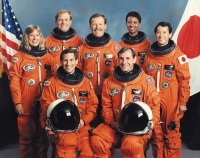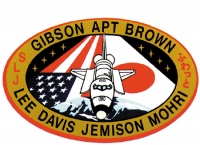STS-47
From The Space Library
 | |
| Organization | NASA-Office of Space Flight (United States),NationalSpaceDevelopmentAgency(NASDA)(Japan) |
|---|---|
| Mission type | Human Crew,Life Science,Microgravity |
| Launch date | September 12, 1992 |
| Launch vehicle | Space Shuttle |
| Launch site | Cape Canaveral, United States |
| COSPAR ID | 1992-061A |
| Inclination | 57 degrees |
| Experiments | Here |
| Alternate Names | Spacelab-J/STS 47,22120 |
| Additional Information | Here |
| Telecommunications Information | Here |
| Data Collection | Here |
| Payload Mass Up | 12772 kg |
| Payload Mass Down | 12799.09 kg |
| Orbiter | Endeavour |
| Lift Off Mass | 2,048,476.82 kg |
| Orbiter Weight at Liftoff | 111,096.82 kg |
| Orbiter Weight at Landing | 99,694.09 kg |
| Landed | Runway 33 at Kennedy Space Center, Fla. |
| Orbits of Earth | 127 |
| Orbital Altitude | 163 nautical miles (188 statute miles) |
Contents |
[edit] Crew
- Commander: Robert L. Gibson
- Pilot: Curtis L. Brown Jr.
- Payload Commander:
- Mission Specialist 1: Mark C. Lee
- Mission Specialist 2: Jerome Apt
- Mission Specialist 3: N. Jan Davis
- Mission Specialist 4: Mae C. Jemison
- Mission Specialist 5:
- Payload Specialist 1: Mamoru Mohri
- Payload Specialist 2:
ISS/Mir Crew Transport
[edit] Mission
STS 47 was the 50th Shuttle mission and flew as its primary payload Spacelab-J (SL-J), utilized pressurized Spacelab module. Jointly sponsored by NASA and the National Space Development Agency (NASDA) of Japan, SL-J included 24 material science and 19 life sciences experiments, of which 34 were sponsored by NASDA, seven by NASA, and two collaborative efforts. The mission was extended one day to further science objectives. The materials science investigations covered such fields as biotechnology, electronic materials, fluid dynamics and transport phenomena, glasses and ceramics, metals and alloys, and acceleration measurements. The life sciences investigations covered human health, cell separation and biology, development biology, animal and human physiology and behavior, space radiation, and biological rhythms. Test subjects included the crew, Japanese koi fish, cultured animal and plant cells, chicken embryos, fruit flies, fungi and plant seeds, and frogs and frog eggs. Also flown in the payload bay were 12 Get Away Special (GAS) canisters (10 holding experiments, two for ballast) attached to a GAS Bridge Assembly. Middeck experiments included Israeli Space Agency Investigation about Hornets (USAIAH); Solid Surface Combustion Experiment (SSCE); Shuttle Amateur Radio Experiment (SAREX II); Air Force Maui Optical Site (AMOS); and Ultraviolet Plume Instrument (UVPI). The crew consisted of mission commander Robert L Gibson, pilot Curtis L. Brown Jr., payload commander Mark C. Lee, mission specialist N. Jan Davis, science mission specialist Mae C. Jemison, and payload specialist Mamoru C. Mohri. Jemison became the first African-American woman to fly in space, Lee and Davis were the first married couple, and Mohri the first Japanese to fly on the Shuttle. The mission duration was 7 days, 22 hours, 30 minutes, and 23 seconds.
[edit] EVA
[edit] Payload
Spacelab-J; nine getaway special canister experiments; Israel Space Agency Investigation About Hornets (ISAIAH); Shuttle Amateur Radio Experiment (SAREX) II; Solid Surface Combustion Experiment (SSCE)
[edit] Books about the Space Shuttle Program
Buy This Book Click here |
Buy This Book here |
Buy This Book Click here |
Buy This Book Click here |





